Non-destructive testing (NDT) is a crucial technique used across various industries to assess the integrity, quality, and performance of materials, components, and structures without causing damage or altering their functionality. NDT methods are designed to identify defects, discontinuities, or anomalies that may affect the object’s performance or safety.

NDT encompasses a wide range of testing techniques, each tailored to specific applications and materials. Some commonly used NDT methods include:
- Visual Inspection: The most basic form of NDT, visual inspection involves visually examining the object for surface defects, corrosion, cracks, or other visible anomalies.
- Ultrasonic Testing: This method uses high-frequency sound waves to detect flaws or measure material thickness. Ultrasonic waves are sent into the material, and the reflected waves are analyzed to determine the presence and characteristics of defects.
- Radiographic Testing: Radiography involves passing X-rays or gamma rays through an object and capturing the resulting image on a radiographic film or digital detector. It is used to detect internal defects or irregularities, such as cracks, voids, or inclusions.
- Magnetic Particle Testing: This method utilizes magnetic fields and magnetic particles to identify surface and near-surface defects in ferromagnetic materials. When a magnetic field is applied, any defects cause the magnetic particles to gather, making them visible under proper lighting conditions.
- Liquid Penetrant Testing: Also known as dye penetrant testing, this method involves applying a liquid dye to the surface of the object. The dye penetrates into surface-breaking defects, and excess dye is removed. A developer is then applied, which draws the trapped dye out, making the defects visible.
- Eddy Current Testing: Eddy current testing utilizes electromagnetic induction to detect surface and near-surface defects in conductive materials. It involves passing an alternating current through a coil, which creates a changing magnetic field that induces eddy currents in the material. The presence of defects alters the eddy current flow, allowing their detection.
These are just a few examples of the numerous NDT methods available, each with its own advantages, limitations, and applications. NDT plays a crucial role in quality control, manufacturing processes, maintenance, and safety assessments in industries such as aerospace, automotive, construction, energy, and manufacturing.
By employing NDT techniques, defects and irregularities can be identified early, allowing for appropriate actions to be taken, such as repairs, maintenance, or component replacement. NDT helps ensure the integrity, reliability, and safety of materials, components, and structures while minimizing the need for destructive testing or unnecessary downtime.